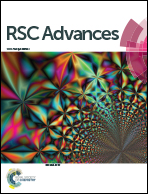Electrochemical potential-responsive tetra(aniline) nanocapsules via self-assembly
Abstract
A simple and effective approach is developed to obtain electroactive TANI nanocapsules via self-assembly. The carboxylic acid doped TANI molecules can self-assemble into nanocapsules through a simple dialysis process. The average diameter of the nanocapsules can be tuned using hydrophilic dopant acids with different alkyl lengths. Furthermore, those electroactive nanocapsules can be disrupted by applying a reducing voltage at −0.1 V.


 Please wait while we load your content...
Please wait while we load your content...